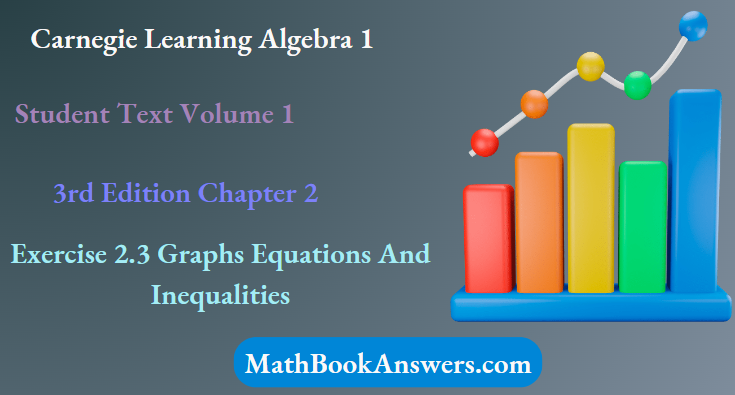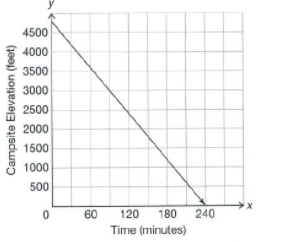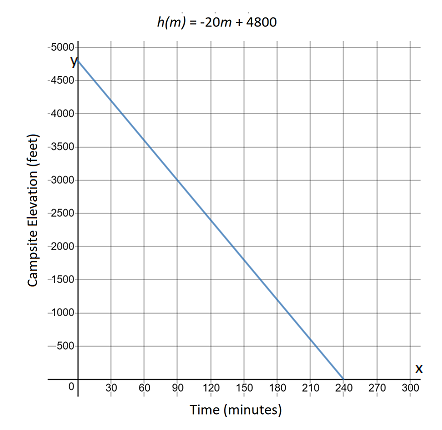Carnegie Learning Algebra I Student Text Volume 1 3rd Edition Chapter 2 Graphs Equations And Inequalities
Page 103 Problem 1 Answer
Given: The cost of each popcorn box $3.75
To find alan’s total sales as a function of the number of boxes of popcorn he sells.Using the method of functions.
Given the cost of each popcorn box $3.75
The price of each popcorn box is constant so the function is linear.
The function is f(b)=m b+c here m is the slope, c is the y−intercept and b is the number of boxes of popcorn sold.
Each box of popcorn is $3.75 the slope is m=3.75
Each student starts with a $25 credit towards sales so the y−intercept is c=25
So, the function is f(b)=3.75b+25
Alan’s total sales as a function of the number of boxes of popcorn he sells are f(b)=3.75b+25
Carnegie Learning Algebra I Student Text Volume 1 3rd Edition Chapter 2 Exercise 2.3 Graphs Equations And Inequalities Page 103 Problem 2 Answer
Given: The function f(b)=3.75b+25
To find the independent and dependent quantities and their units.Using the method of functions.
Given the function f(b)=3.75b+25 here f(b)=3.75b+25 represent Alan’s total sales as a function of the number of boxes of popcorn he sells.
The independent quantity in this is b/ b is the unit of several boxes of popcorn he sells.
The dependent quantity is f(b)/f(b) is the unit of sales in dollars
The independent quantity is b and its unit is several boxes of popcorn he sells.
The dependent quantity is f(b) and its unit is sales in dollars.

Page 103 Problem 3 Answer
Given: The function f(b)=3.75b+25
To find the rate of change.Using the method of functions.
Given the function f(b)=3.75b+25
The rate of change here is the slope.
where slope is m here m=3.75
so, the rate of change is m=3.75
This represents the price of each popcorn box
The rate of change is m=3.75 which represents the slope of the function.
Page 105 Problem 4 Answer
Given: The graph which represents the change in the total sales as a function of boxes sold.
To find: the difference between the open and closed circles on the number lines.
Method used: Inequality theorem
An open circle indictes “less than” or “greater than,” while a closed circle indicates “greater than or equal to” or “less than or equal to”.
This number line includes values that are less than or greater than or equal to.
The number line includes values that are less than or greater than or equal to.
Carnegie Learning Algebra I Chapter 2 Exercise 2.3 Solutions
Carnegie Learning Algebra I Student Text Volume 1 3rd Edition Chapter 2 Exercise 2.3 Graphs Equations And Inequalities Page 105 Problem 5 Answer
Given : The graph for total sales to number of boxes sold is given
To find: How many boxes would Alan have to sell to earn at least $ 925
Method used: Inequality theorem
We have the equation
$925≤3.75b+25 Switch sides
3.75b+25≥925
Multiply both sides by 100
3.75b×100+25×100≥925×100
Refine 375b+2500≥92500
Subtract 2500 from both sides
375b+2500−2500≥92500−2500
Simplify 375b≥90000
Divide both sides by 375/375b
375≥90000/375
Simplify b≥240
The number of boxes would Alan have to sell to earn at least $ 925 is 240
Page 106 Problem 6 Answer
Given: Alan needs to sell at least 287 boxes of popcorn to earn two 55 gift cards.To find why the answer rounded to $287.
Using the method of functional.
To find the why the answer rounded are,
The number of boxes must be a whole number so if b≥286.66…,
Then it must be rounded up to 287 since 287 is the smallest whole number that is greater than or equal to 286.66……
If the inequality had been b≤286.66…,
Then it would have been rounded down to 286 since 286 is the largest whole number that is less than or equal to 286.66…
The number of boxes must be a whole number and 287 is the smallest whole number that is greater than or equal to 286.66…
Carnegie Learning Algebra I Student Text Volume 1 3rd Edition Chapter 2 Exercise 2.3 Graphs Equations And Inequalities Page 106 Problem 7 Answer
Given: Write and solve an inequality for each. Show your work.
To solve the greatest number of boxes Alan could sell and still not have enough to earn the Cyclone Sprayer.
Using the method of inequality.
To find the the greatest number of boxes are,
A Cyclone Sprayer requires $600 n sales so if he doesn’t have enough to earn the Cyclone Sprayer,
Thenf(b)<600.
Substitutef(b)=3.75b+25 into this inequality and then solve for $b
f(b)<600
3.75b+25<600
3.75b<575
3.75b/3.75<575/3.75
b<153.33…
b$ must be less than153.33… you must round down to 153.
Therefore, the greatest number of boxes he can sell and not have enough to earn the Cyclone Sprayer is 153 boxes.
The greatest number of boxes he can sell and not have enough to earn the Cyclone Sprayer is 153 boxes.
Page 106 Problem 8 Answer
Given: Write and solve an inequality for each. Show your work.
To solve how many boxes would Alan have to sell to be able to choose his own prize.
Using the method of inequality.
To find how many boxes,
To choose his own prize, he must earn at least $1500 sof(b)≥1500.
Substitute f(b)=3.75b+25 into this inequality and then solve for $b
f(b)≥1500
3.75b+25≥1500
3.75b≥1475
3.75b/3.75≥1475/3.75
b≥393.33…
b$ must be greater than or equal to 393.33… you must round up to 394.
Therefore, he must sell at least 394 boxes to choose his own prize.
The must sell at least 394 boxes to choose his own prize.
Graphs, Equations, And Inequalities Chapter 2 Exercise 2.3 Answers
Carnegie Learning Algebra I Student Text Volume 1 3rd Edition Chapter 2 Exercise 2.3 Graphs Equations And InequalitiesPage 107 Problem 9 Answer
Given: Alan’s camping troop hikes down from their campsite at an elevation of 4800 feet to the bottom of the mountain.
To find a function, h(m) to show the troop’s elevation as a function of time in minutes.
Using the method of functional.
To find the troop’s elevation as a function of time in minutes,
The rate of change is constant to the function is linear and of the form h(m)= s m+b
Wheres is the slope, m is the number of minutes, and b is the y−intercept.
They are hiking down at a rate of 20 feet per minute so s=−20.
They start at an initial height of 4800 feet so b=4800.
The function is then h(m)=−20m+4800.
A function of time in minutes value are,h(m)=−20m+4800.
Page 107 Problem 10 Answer
Given: Alan’s camping troop hikes down from their campsite at an elevation of 4800 feet to the bottom of the mountain.
To identify the independent and dependent quantities and their units.Using the explanation method.
To find the independent and dependent quantities and their units are,
The two quantities are elevation, in feet, and time, in minutes.
Since the elevation of the troops depends on the time,
Time is the independent quantity and has units of minutes and elevation is the dependent quantity and has units of feet.
The independent quantity is time, in minutes, and the dependent quantity is elevation, in feet.
Page 107 Problem 11 Answer
Given: Alan’s camping troop hikes down from their campsite at an elevation of 4800 feet to the bottom of the mountain.
To identify the rate of change and explain what it means in terms of this problem situation.Using the functional method.
To find what it means in terms of this problem situation are,
The troop is climbing down the mountain at a rate of 20 feet per minute so the slope is −20 and Represents the number of feet the troop climbs down per minute.
−20 and represents the number of feet the troop climbs down each minute.
Carnegie Learning Algebra I Student Text Volume 1 3rd Edition Chapter 2 Exercise 2.3 Graphs Equations And Inequalities Page 107 Problem 12 Answer
Given: Alan’s camping troop hikes down from their campsite at an elevation of 4800 feet to the bottom of the mountain.
To find they−intercept and explain what it means in terms of this problem situation.Using the explanation method.
To find what it means in terms of this problem situation are,
The y−intercept is the troop’s initial elevation so the y−intercept is 4800 since they start at an elevation of 4800 feet.
The 4800 and represents the initial elevation of the troop.
Page 107 Problem 13 Answer
Given: Alan’s camping troop hikes down from their campsite at an elevation of 4800 feet to the bottom of the mountain.
To find thex−intercept and explain what it means in terms of this problem situation.Using the method of functional.
To find the what it means in terms of this problem situation are,
The x−intercept is when the troops have reached the bottom of the mountain.
They must climb down 4800 feet and are climbing down at a rate of 20 feet per minute so it will take them 4800/20
=240 minutes to climb down the mountain.
The x−intercept is then 240.
The240 and represents the number of minutes it takes for the troops to reach the bottom of the mountain.
Page 108 Problem 14 Answer
Given:

To find the function on the coordinate plane.
Using the method of graphical.
To find the function on the coordinate plane.
From Question l, the function ish(m)=−20m+4800
so write h(m)=−20m+4800 on the graph given in your book.

The function on the coordinate plane are:

Carnegie Learning Algebra I Exercise 2.3 Solutions Guide
Page 108 Problem 15 Answer
Given: Write and solve an inequality to verify the solution set.
To solve an inequality to verify the solution set you interpreted from the graph.Using the method of inequality.
To find the solution set you interpreted from the graph,
Substitute h(m)=−20m+4800 into the inequality h(m)<3200 from Question4.
Then solve for m.
Remember to switch the inequality sign when dividing both sides by−20:
h(m)<3200
−20m+4800<3200
−20m<−1600
−20m
−20>−1600
−20m>80
This matches with the solution of hiking more than 80 minutes to reach an elevation below 3200 feet from Question 4.
The solving h(m)<3200 gives m>80 which matches with the solution of hiking more than 80 minutes to reach an elevation below 3200 feet from Question4.
Carnegie Learning Algebra I Student Text Volume 1 3rd Edition Chapter 2 Exercise 2.3 Graphs Equations And Inequalities Page 108 Problem 16 Answer
Given: Compare and contrast your solution sets using the graph and the function.
To find the what do you notice.Using the method of functional.
To find the both solution sets were m>80.
The solution set of m>80 for the graph was an estimate that happened to be the same as the exact solution found using the function.
Both solution sets were m>80.
The solution set of m>80 for the graph was an estimate that happened to be the same as the exact solution found using the function.
Page 109 Problem 17 Answer
Given:
|h(m)|
|h(m)>3200|
|(m)≥3200|
|h(m)=3200|
|h(m)<3200|
|h(m)≤3200|
|m|
To find the what do you notice about the inequality signs.Using the method of inequality.
The graph passes through the point(80,3200).
For values of m<80,h(m) is greater than 3200 and form<80,h(m) is less than 3200.
The table is then filled in as follows:
|h(m) |m|
|h(m)>3200|m<80|
|h(m)≥3200|m≤80|
|h(m)=3200|m=80|
|h(m)<3200|m>80|
|h(m)≤3200||m≥80|
The inequality sign for m is the reverse of the inequality sign for h(m).
If the inequality for h(m) has an equals then so does the inequality sign form.
The inequality sign form is the reverse of the inequality sign for h(m).
If the inequality for h(m) has an equals then so does the inequality sign form.
|h(m) |m|
|h(m)>3200|m<80|
|h(m)≥3200|m≤80|
|h(m)=3200|m=80|
|h(m)<3200|m>80|
|h(m)≤3200||m≥80|
Carnegie Learning Algebra I Student Text Volume 1 3rd Edition Chapter 2 Exercise 2.3 Graphs Equations And Inequalities Page 109 Problem 18 Answer
Given:
|h(m) |
|h(m)>3200|
|(m)≥3200 |
|h(m)=3200|
|h(m)<3200|
|h(m)≤3200|
|m |
To find what you know about solving inequalities when you have to multiply or divide by a negative number.Using the method of inequality.
To find the multiply or divide by a negative number are,
Solving an inequality doesn’t remove or add the equal part of the inequality sign so if h(m) has an equals in its inequality sign then m must also have one.
Since h(m)=−20m+4800, when solving the inequalities, both sides will have to be divided by−20.
Since you are dividing both sides by a negative number,
The inequality sign must be switched which is why h(m) and m have opposite facing inequality signs.
Solving an inequality doesn’t change the equal part of the inequality sign so if h(m) has an equals in its inequality sign then m must also.
When solving the inequalities, both sides will have to be divided by −20 so the inequality sign must be switched which is why h(m) and m have opposite facing inequality signs.
Page 110 Problem 19 Answer
Given: f(b)=3.75b+25 and the function.To solve inequalities involving the function.
Using the method of inequality.
To find the inequalities involving the function are,When solving inequalities involving the function f(b)=3.75b+25, the inequality is solved just like an equation.
When solving inequalities involving the function h(m)=−20m+4800,
The inequality is solved just like an equation, except the inequality sign must be reversed when you divide both sides by −20 to solve form.
Both get solved like equations except when solving an inequality for m that involves h(m)=−20m+4800 you must reverse the inequality sign when you divide both sides by −20.
Exercise 2.3 Graphs, Equations, And Inequalities Explained
Carnegie Learning Algebra I Student Text Volume 1 3rd Edition Chapter 2 Exercise 2.3 Graphs Equations And Inequalities Page 110 Problem 20 Answer
Given: −2/3 x≥7.
To solve each inequality and then graph the solution on the number line.
Using the method of inequality.
To find the inequality and then graph the solution on the number line are,

To solve −2/3x≥7, multiply both sides by the reciprocal of −2/3 which is −3/2.
Remember to switch the inequality sign since you are multiplying both sides by a negative number.
Write the answer in decimal form so it is easier to graph:
−2/3x≥7
−3/2⋅−2/3x≤−3
2⋅7 x≤−21/2
x≤−10.5
To graph the inequality, plot a closed circle at−10.5 since the inequality sign has an equals.
Then shade to the left since x must be less than or equal to−10.5:
The inequality and then graph the solution on the number line.
x≤−10.5

Page 110 Problem 21 Answer
Given:32>23−x.To solve each inequality and then graph the solution on the number line.
Using the method of inequality.
To solve 32>23−x,
subtract23 on both sides, multiply both sides by −1, and then reverse the inequality so x is on the left side.

Remember to switch the inequality sign when multiplying both sides by −1.
32>23−x
32−23>23−x−23
9>−x
−1⋅9<−1⋅−x
−9<x
x>−9
To graph the inequality, plot an open circle at −9 since the inequality sign does not have an equals.
Then shade to the right since x must be greater than−9.
The inequality and then graph the solution on the number line are, x>−9

Page 110 Problem 22 Answer
Given: 2(x+6)<10.
To solve each inequality and then graph the solution on the number line.
Using the method of inequality.
To solve2(x+6)<10,
Divide both sides by 2 and then subtract 6on both sides:
2(x+6)<10
2(x+6)/2<10/2
x+6<5
x+6−6<5−6
x<−1
To graph the inequality, plot an open circle at −1 since the inequality sign does not have an equals.
Then shade to the left since x must be less than−1:

The inequality and then graph the solution on the number line are,x<−1

